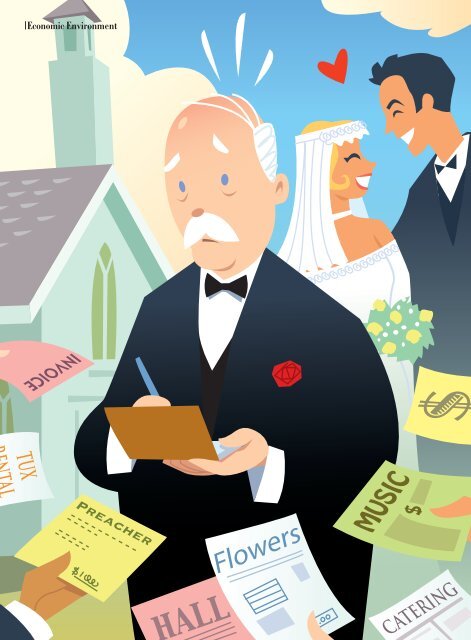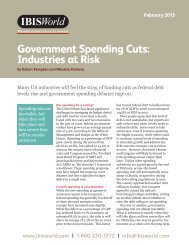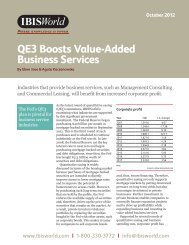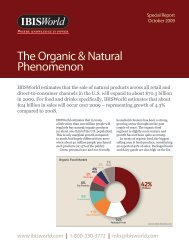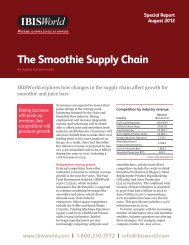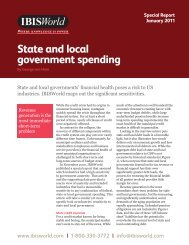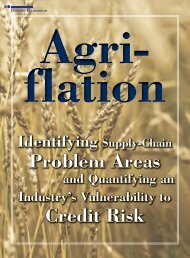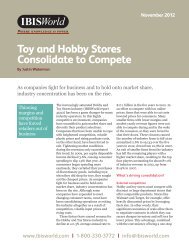Wedding Industry - IBISWorld
Wedding Industry - IBISWorld
Wedding Industry - IBISWorld
Create successful ePaper yourself
Turn your PDF publications into a flip-book with our unique Google optimized e-Paper software.
Economic Environment<br />
Flowers<br />
December 2010–January 2011 The RMA Journal
<strong>Wedding</strong> Bells<br />
Are Ringing<br />
••After a downturn caused by a troubled economy<br />
and fewer marriages, wedding-related businesses<br />
are on the rebound.<br />
Liquidlibrary, Hemera/Thinkstock<br />
b y To o n va n Be e c k a n d Ge o r g e Va n Ho r n<br />
Wh i l e n o t a n industry in itself, the wedding business is<br />
a key revenue contributor to a diverse mix of local businesses.<br />
<strong>Wedding</strong>s are customized, and therefore not prone<br />
to efficiency, and they often occur on an irregular timeline.<br />
The clients (bride and groom) dream of perfection, while<br />
someone else (their parents) usually pays the bills.<br />
In the same way department stores rely on the holiday<br />
season to help define the ultimate success of their year,<br />
many small business operators depend on the number and<br />
extravagance of wedding events to distinguish a good year<br />
from a bad one.<br />
This article provides a quick evaluation of the wedding<br />
industry’s contribution to local economies and the small<br />
army of business service providers that support it. Highlighted<br />
here are the health of the wedding business, the<br />
size of the market, and the reliance of key industries on<br />
wedding-related revenue.<br />
Going to the Chapel<br />
<strong>Wedding</strong>s are big business. From the proposal to the return<br />
flight of a honeymoon, a typical wedding will have a direct<br />
and indirect impact on more than 100 industries. The list<br />
ranges from gold mining to travel agencies, but in this<br />
article we will look only at industries directly affected by the<br />
wedding event. While this categorization whittles down the<br />
industry impact considerably, the wedding market remains<br />
a sizable $47.2 billion sector.<br />
Let’s put this revenue in perspective: If weddings were<br />
compared to holiday-generated spending, they would rank<br />
just behind Christmas and easily ahead of Thanksgiving.<br />
The infrequency of weddings is more than made up for<br />
by their extravagance. They generate more revenue than<br />
Valentine’s Day, Mother’s Day, and Easter combined.<br />
One cause of concern is that the number of couples tying<br />
the knot has been in a persistent decline. Marriage rates have<br />
tumbled over the past few decades, falling from about 10<br />
marriages per 1,000 people in the mid-1980s to 6.8 marriages<br />
in 2009. This decline is a result of social influences<br />
(fewer couples looking to commit) and attitudinal changes,<br />
as consumers hold off for financial and lifestyle reasons.<br />
However, the fall in the marriage rate has not resulted in a<br />
complete disaster for the industry. In fact, the decline has<br />
led to a higher-than-average wedding spend, meaning even<br />
greater profits for those involved (Figure 1).<br />
The <strong>Wedding</strong> <strong>Industry</strong> and the Economy<br />
Coming off of 2005 and 2006, two of the most prosperous<br />
years in the wedding industry, the sector plummeted as the<br />
economy entered recession. Revenues fell from a high of<br />
$67.5 billion in 2005 to $42.9 billion in 2009. <strong>Industry</strong><br />
performance is expected to improve in 2010, expanding<br />
an estimated 10% to $47.2 billion, but still far below the<br />
The RMA Journal December 2010–January 2011 23<br />
Copyright 2010 by RMA
Figure 1<br />
Number of <strong>Wedding</strong>s versus Average <strong>Wedding</strong> Spend<br />
2,600,000<br />
2,500,000<br />
2,400,000<br />
2,300,000<br />
2,200,000<br />
2,100,000<br />
2,000,000<br />
1,900,000<br />
1985<br />
1986<br />
1987<br />
1988<br />
1989<br />
1990<br />
1991<br />
1992<br />
1993<br />
1994<br />
1995<br />
1996<br />
1997<br />
1998<br />
1999<br />
2000<br />
2001<br />
2002<br />
2003<br />
2004<br />
2005<br />
2006<br />
2007<br />
2008<br />
2009<br />
2010<br />
Number of <strong>Wedding</strong>s (LHS)<br />
*In 2010 constant U.S. dollars<br />
*Average <strong>Wedding</strong> Spend (RHS)<br />
$35,000<br />
$30,000<br />
$25,000<br />
$20,000<br />
$15,000<br />
$10,000<br />
$5,000<br />
$0<br />
Source: <strong>IBISWorld</strong> estimates<br />
years, so businesses need to put in place appropriate<br />
strategies to capture that increasing demand.<br />
The average engagement time in the United<br />
States is 17 months, so long-term targeting and<br />
retaining strategies must be implemented. Additionally,<br />
businesses need to take proper financial<br />
considerations into account because the product<br />
or service in demand may be months away from<br />
payment and delivery. Planning for the future, along<br />
with having a good customer base, is essential for<br />
those involved in the wedding industry. Unlike<br />
other industries, sales are not typically day-to-day<br />
transactions. They are sizable decisions that take<br />
time to plan and implement, for both the customer<br />
and the company involved.<br />
The <strong>Wedding</strong> <strong>Industry</strong>’s Seven Core Sectors<br />
<strong>IBISWorld</strong> has identified seven core sectors within<br />
the wedding industry. These sectors are grouped<br />
together because they represent key inputs to the<br />
high of just five years earlier. As shown in Figure 2,<br />
the wedding market is expected to remain on this<br />
upward trend through 2015, with 2009 expected<br />
to be the low point for the sector.<br />
While swings in the economy greatly affect<br />
spending per wedding, the underlying demographics<br />
are slowly improving. The decline in population<br />
growth of the 20- to 34-year-old age bracket<br />
bottomed out between 1997 and 2002, and those<br />
in that bracket<br />
The positive revenue<br />
outlook for the next five<br />
years offers weddingdependent<br />
companies<br />
great opportunities<br />
to build business<br />
and increase their<br />
competitiveness.<br />
who are contributing<br />
to the<br />
rising population<br />
totals are<br />
quickly approaching<br />
the<br />
median age<br />
Figure 2<br />
for first marriages.<br />
Annualized<br />
growth<br />
in the 20- to<br />
34-year-old group over<br />
the five years to the end of 2013 is projected at 1.2%,<br />
a significant improvement over the growth rates for the<br />
prior two five-year periods, which were 0.6% and 0.4%,<br />
respectively (Figure 3).<br />
The positive revenue outlook for the next five years offers<br />
wedding-dependent companies great opportunities to build<br />
business and increase their competitiveness. Thousands of<br />
weddings were put on hold during the recession because<br />
couples and their parents were financially strapped. There<br />
will likely be a strong uptick in weddings over the next three<br />
$Millions<br />
$80,000<br />
$70,000<br />
$60,000<br />
$50,000<br />
$40,000<br />
$30,000<br />
$20,000<br />
$10,000<br />
$0<br />
2000<br />
2001<br />
U.S. <strong>Wedding</strong> Market Revenue<br />
2002<br />
2003<br />
2004<br />
2005<br />
2006<br />
2007<br />
2008<br />
wedding planning process. Yet they are differentiated by<br />
their varied products and services. Few companies in the<br />
wedding industry actually provide services for an entire<br />
wedding (that’s the job of the wedding planner) because<br />
each couple has specific demands that no one company<br />
can meet on a regular basis.<br />
The seven sectors include reception, wedding attire,<br />
wedding rings, photography, flowers, wedding planners,<br />
and other (Figure 4). Within reception, wedding attire,<br />
and other, multiple and often highly diversified industries<br />
generate wedding revenue.<br />
2009<br />
2010<br />
2011<br />
2012<br />
2013<br />
2014<br />
2015<br />
Source: <strong>IBISWorld</strong> estimates<br />
24<br />
December 2010–January 2011 The RMA Journal
Clearly, all of these categories have a sizable<br />
sensitivity to wedding demand drivers such as<br />
number of engagements, per capita disposable<br />
income, unemployment levels and job security,<br />
and consumer confidence. At the same time, each<br />
of the seven revenue sources has unique risks and<br />
key success factors. The wedding industry cannot<br />
be grouped into a single frame when determining<br />
how much a lender may need to financially support<br />
a business. Rather, each sector must be reviewed<br />
individually and its operators evaluated in terms of<br />
other sources of revenue and the competition from<br />
other industries providing similar services.<br />
Figure 3<br />
64,000,000<br />
63,000,000<br />
62,000,000<br />
61,000,000<br />
60,000,000<br />
59,000,000<br />
58,000,000<br />
Total Population 20-34 and Median Age<br />
at First Marriage<br />
28<br />
27<br />
26<br />
25<br />
24<br />
23<br />
The Reception<br />
The reception is the biggest expense of a wedding,<br />
generating an estimated 38% of total industry revenue<br />
($17.94 billion in 2010). The reception sector<br />
can be broadly classified as the “accommodation<br />
and food services” division. Major costs associated<br />
with the reception include venue rental, food and beverages,<br />
food service and bartender, wedding cake, and hotel for<br />
the bride and groom.<br />
Customers spend a considerable amount of time choosing<br />
the reception location and making it fit their demands.<br />
For this reason, the reception operates with unique risks<br />
compared to other categories. Potential customers can be<br />
deterred from choosing a specific location or company<br />
over minor issues, and that equates to a loss of business<br />
opportunity.<br />
Like all industries, firms in this area must continually<br />
meet and satisfy their key success factors so that they remain<br />
competitive and viable. Table 1 shows six related <strong>IBISWorld</strong><br />
industries that have direct influence on the wedding market<br />
and fall into the accommodation and food services sector.<br />
From a wedding perspective, these figures show opportunities<br />
for new businesses. Operators within the<br />
industries low on the list can seek to capitalize on<br />
an improving wedding industry by directing more<br />
of their marketing toward this potential clientele.<br />
Developing good word-of-mouth recommendations,<br />
fostering excellent customer relations, having a welltrained<br />
staff, and implementing appropriate pricing<br />
policies will help moderate the business risks associated<br />
with this highly competitive sector.<br />
<strong>Wedding</strong> Attire<br />
The wedding attire category incorporates the retail,<br />
rental, and personal services sectors. However, most<br />
of the category is related to the retail sector, where<br />
product and service substitutes abound. Customers<br />
are able to move easily from business to business<br />
in search of outfits and accessories.<br />
57,000,000<br />
56,000,000<br />
1980 1982 1984 1986 1988 1990 1992 1994 1996 1998 2000 2002 2004 2006 2008<br />
Figure 4<br />
Total Population 20-34 (L)<br />
<strong>IBISWorld</strong> has identified eight industries with a direct<br />
effect on the wedding attire category (Table 2). Major selling<br />
items include the<br />
bridal dress, groom<br />
and groomsmen attire,<br />
bride and groom accessories,<br />
bridesmaid<br />
outfits and accessories,<br />
and hair and makeup.<br />
This sector is estimated<br />
to account for 12.4% of<br />
total spending, coming<br />
in at $5.85 billion.<br />
Medium Age at First Marriage (R)<br />
Substitution is a huge competitive disadvantage for wedding<br />
firms specializing in the attire market. This factor is<br />
particularly true for formal wear and costume rental, given<br />
The Seven Revenue-Generating Areas<br />
<strong>Wedding</strong> Size: $47.2 billion—2010<br />
<strong>Wedding</strong> Planners<br />
2.0%<br />
Flowers<br />
4.5% Photography<br />
8.8%<br />
Other<br />
24.1%<br />
<strong>Wedding</strong> Rings<br />
10.2%<br />
22<br />
21<br />
Source: <strong>IBISWorld</strong> estimates<br />
The wedding industry<br />
cannot be grouped<br />
into a single frame<br />
when determining how<br />
much a lender may<br />
need to financially<br />
support a business.<br />
<strong>Wedding</strong> Attire<br />
12.4%<br />
Reception<br />
38.0%<br />
Source: <strong>IBISWorld</strong> estimates<br />
The RMA Journal December 2010–January 2011 25
Table 1<br />
<strong>Wedding</strong>-related Accommodation and Food Services Industries<br />
Growth<br />
Reception: Related Industries 2007-2009 2010 2009-2012<br />
Hotels & Motels -3.1% 1.3% 3.0%<br />
Single Location Full-Service Restaurants -2.8% 3.1% 2.9%<br />
Chain Full-Service Restaurants -2.4% 3.1% 2.6%<br />
Bars, Nightclubs & Drinking Establishments -5.3% 1.1% 2.6%<br />
Caterers -0.8% -1.1% 1.7%<br />
Bed & Breakfast & Hotel Accommodations -3.8% 0.5% 1.3%<br />
Table 2<br />
<strong>Wedding</strong> Attire Industries<br />
Related <strong>IBISWorld</strong> Industries<br />
Growth<br />
Source: <strong>IBISWorld</strong><br />
<strong>Wedding</strong> Attire: Related Industries 2007-2009 2010 2009-2012<br />
Clothing Accessories Stores 0.7% 3.8% 5.3%<br />
Hair & Hair Salons -3.0% 2.0% 2.6%<br />
Lingerie, Swimwear, Uniform & Bridal Stores -10.2% 1.2% 2.3%<br />
Women’s Clothing Stores -4.7% 1.3% 1.5%<br />
Shoe Stores -5.0% 0.2% 1.4%<br />
Formal Wear & Costume Rental -.07% -3.0% -1.1%<br />
Men’s Clothing Stores -4.2% -2.6% -1.5%<br />
Department Stores -5.3% -1.5% -2.5%<br />
Table 3<br />
<strong>Wedding</strong> Ring and Flower Industries<br />
Growth<br />
Source: <strong>IBISWorld</strong><br />
<strong>Wedding</strong> Rings & Flowers: Related Industries 2007-2009 2010 2009-2012<br />
Jewelry Stores -4.6% -0.8% 1.2%<br />
Florists -7.4% -1.4% -0.6%<br />
Source: <strong>IBISWorld</strong><br />
that an estimated 30% of this industry’s revenue comes from<br />
suit and tuxedo rentals for weddings. <strong>IBISWorld</strong> has identified<br />
the growth in cheap imports from China as one of the<br />
greatest threats to this industry. More men are purchasing<br />
these imports instead of renting their attire as the price<br />
difference between renting and buying diminishes. As a<br />
result, risks for the formal-wear industry have heightened<br />
over the past few years, something financial lenders need<br />
to be aware of if they intend to serve this sector.<br />
Consistent with most retail operations, the need to adequately<br />
control stock on hand has become increasingly<br />
important to the health and viability of individual operators.<br />
Thousands of retail businesses have experienced considerable<br />
financial losses due to deep discounting and slumping<br />
retail profits over the past several years. The margin of error<br />
between an oversupply of inventory during bad times and<br />
a shortage of inventory during good times is crucial to the<br />
financial health of any single operator.<br />
<strong>Wedding</strong> Rings and Flowers<br />
Two more sectors—rings and flowers—also fall within the<br />
retail spectrum of industry analysis. The jewelry market<br />
has long been considered one of the higher-risk industries<br />
in the United States, receiving a very high risk rating from<br />
<strong>IBISWorld</strong>. Over the next 18 months, however, industry risk<br />
will fall into the medium-to-high risk band. The lowered<br />
risk is attributable to improving economic conditions, an<br />
expected decline in unemployment, rising per capita disposable<br />
income, and a stronger wedding market.<br />
The jewelry industry is characterized by very high and<br />
increasing levels of competition, but it has a profit margin<br />
of 10.4%, well above the 7.5% average for the retail sector<br />
as a whole. Jewelry markets are in a strong position to<br />
maintain and grow operations, but lenders must ensure<br />
that profit margins are not jeopardized by the high levels<br />
of competition in this industry.<br />
On the other hand, the florist market is expected to have<br />
a high risk rating in the next 18 months, given that it faces<br />
strong competition from the supermarket and grocery store<br />
industry. Florists will need to focus on individual retailing<br />
segments and special occasions to improve their overall<br />
competitive position. Accounting for about 55% of industry<br />
revenue, cut-flower arrangements represent a major segment<br />
for florists. For those specializing in weddings, this<br />
segment often can generate more than 80% of revenue.<br />
Additionally, the margins associated with a wedding are<br />
very rewarding for businesses that can control stock levels<br />
and implement high levels of quality control. Nonetheless,<br />
having all your eggs in one basket is a high-risk/high-reward<br />
approach for a florist. A look at the history of key sales and<br />
their consistency throughout the year will help minimize<br />
lending risk in this category (Table 3).<br />
Photography<br />
<strong>Wedding</strong>s are the primary source of revenue within the<br />
photography industry, generating 45.5% of industry revenue.<br />
There are no obvious large players in this segment.<br />
Operators generally service specific geographic regions—<br />
from low-cost, part-time photographers to elite, high-end<br />
service providers. These businesses have low start-up costs<br />
and investment requirements, making them a successful<br />
lending proposition. They do not require a great deal of cash<br />
to finance their operations, which reduces lending risk.<br />
<strong>Wedding</strong> photography has been one of the fastest growing<br />
segments in the photography industry in recent years.<br />
The average expenditure on photography for an American<br />
26<br />
December 2010–January 2011 The RMA Journal
couple reached about $2,500 in 2008, up from less than<br />
$1,000 in 1999. More wedding photos are now being taken<br />
and purchased, while improved post-production services<br />
are a way to add value to increase revenue. This trend<br />
bodes well for lenders, but high photography skills, wordof-mouth<br />
recommendations, and project management ability<br />
are all required for a wedding photographer to succeed.<br />
Furthermore, photography is one of the highest discretionary<br />
areas within the wedding market. During tough times,<br />
many couples will turn to friends and family to produce<br />
the memories of their special day.<br />
<strong>Wedding</strong> Planners<br />
Planning a wedding can be very daunting for some couples<br />
and their families. For those who choose to hire a wedding<br />
planner, this expenditure can be one of the highest costs.<br />
Not all couples hire wedding planners, which increases the<br />
risk for this sector because it accounts for greater discretionary<br />
spending than many of the other wedding sectors. While<br />
only 2% of total wedding market revenue is derived from<br />
wedding planners, it can often be above 20% for individual<br />
weddings because a couple may hire a wedding planner to<br />
organize everything from A to Z.<br />
<strong>Wedding</strong> planners experience risks similar to those faced<br />
by other wedding sectors. After all, in arranging a wedding,<br />
the planner deals with every one of those industries. One of<br />
the biggest constraints for wedding planners is incorporating<br />
their markups on top of prices quoted by third parties.<br />
Successful wedding planners maintain strong relationships<br />
with a wide range of service providers, have a good reputation,<br />
and are able to provide unique solutions to meet<br />
individual client demands. Lenders must recognize these<br />
success factors and understand the financial responsibilities<br />
and liabilities involved when wedding planners are managing<br />
multiple service providers.<br />
The “Other” Category<br />
“Other” captures all the remaining items that a typical wedding<br />
includes. Some are more traditional purchases (invitations,<br />
reply cards, and rehearsal dinners), while others are<br />
more discretionary in nature (transportation and music).<br />
For nearly all of these services, there can be a high risk of<br />
product or service substitution, and an operator without<br />
significant recognition will experience low customer attainment<br />
and sales.<br />
Conclusion<br />
Ranging from accommodation and food services to retail,<br />
transportation, and professional services, the industries<br />
involved in organizing and carrying out a single wedding<br />
event are significant. For industries with a high revenue<br />
concentration associated with weddings (such as wedding<br />
planners and photographers), the success of their business<br />
is linked directly to the economic and social trends affecting<br />
wedding spending. For the many other service providers,<br />
wedding-related revenues are a key variable in business<br />
performance and profitability.<br />
For lenders to these businesses, the high level of competition<br />
and the ease of substitution among service providers<br />
pose additional business risks. Since getting repeat business<br />
from satisfied customers has its limits, the most successful<br />
operators benefit from consistently high word-of-mouth<br />
recommendations and referrals. Given the length of time<br />
from engagement announcement to wedding day, operators<br />
with a strong track record and well-established businesses<br />
will have a distinct advantage in generating and managing<br />
an order book consistent with their business capacity. v<br />
••<br />
Toon van Beeck and George Van Horn are senior analysts with <strong>IBISWorld</strong>. They can<br />
be reached at toonv@ibisworld.com and georgev@ibisworld.com.<br />
Call for Articles: Back to the Basics<br />
RMA Journal readers can’t get enough of “how<br />
to” articles that explain the basics of lending. And nobody<br />
writes those articles better than bankers. Please consider<br />
sharing your expertise by writing a “how to” feature, such<br />
as how to analyze cash flow, how to choose an appraiser,<br />
or how to prepare for a meeting with a potential customer.<br />
Do you have experience in lending to a particular<br />
niche? Other RMA members could benefit from your<br />
experience in lending to gas stations, churches, or spas.<br />
In this environment, almost everybody has experienced<br />
a loss on a credit that never should have been approved<br />
in the first place. Consider telling your tale in a Spilled<br />
Milk feature, using fictitious names for the customer (and<br />
even the bank). We can all learn from our mistakes.<br />
You don’t have to be a great writer. Just get the facts<br />
down in written form, and The RMA Journal editors will<br />
polish your prose while you put a shine on your career<br />
as a published author. Contact Journal editor Kathie<br />
Beans, kbeans@rmahq.org, with questions or an article<br />
proposal.<br />
The RMA Journal December 2010–January 2011 27


